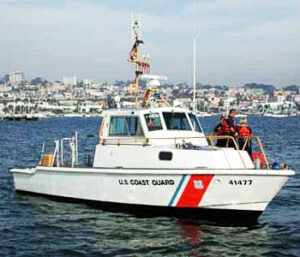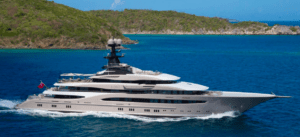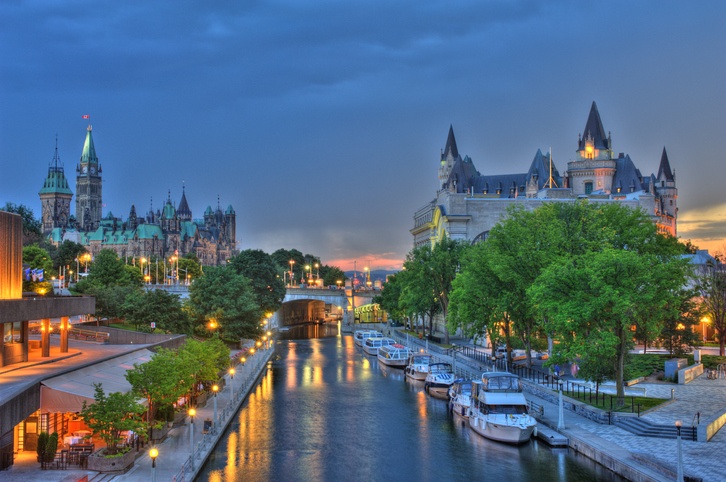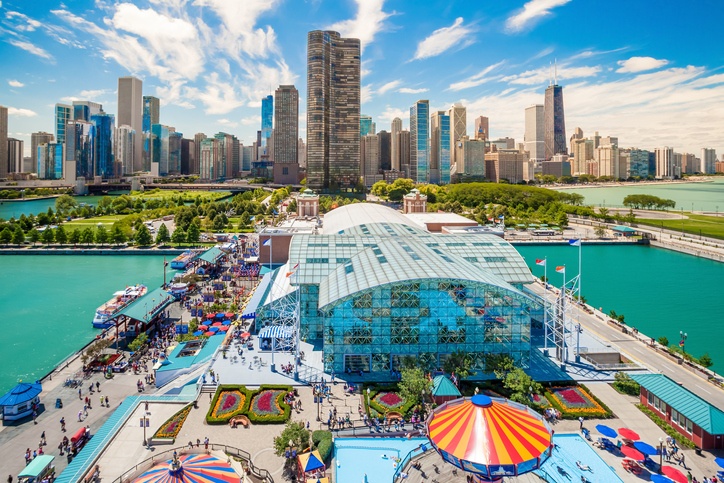In the Heart of Thunderbolt, GA – Where Southern hospitality meets the supernatural
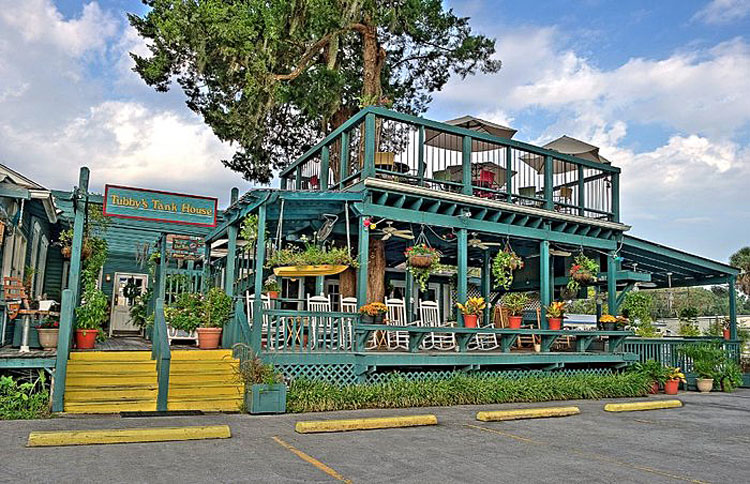
Estimated reading time: 8 minutes – SBFL* Stop 33 – All the thunder and whispers started when the Hampton Lillibridge House, number 310 East Bryan Street in Thunderbolt, Georgia, was moved to a new location. Welcome aboard, fellow travelers and thrill-seekers! As we continue our Slow Boat to Florida* trip tracing the path of the Intracoastal Waterway (ICW), we’re about to dive into a chapter of our adventure that’s sure to send chills down your spine.
Our Slow Boat to Florida series, inspired by the work of National Geographic authors Allan C. Fisher, Jr. (published in 1973*) and his colleagues Dorothea and Stuart E. Jones (published in 1958*) has taken us to many fascinating locations on the ICW. Yet, none quite compare to the spectral charm we’ve uncovered in Thunderbolt, Georgia, which was visited by Fisher. A mere stone’s throw away from Hilton Head and a charming suburb of Savannah, Thunderbolt holds within its boundaries something rather uncanny—one of the South’s most celebrated haunted houses.
Nestled amidst comforting Southern elegance, this quaint abode hides a history as tumultuous as a stormy night. The house, originally at 310 East Bryan Street, was moved, and with that move, the house seemed to awaken, its ghostly tales stirring with life.
The whispers of its spectral inhabitants have woven their way into local lore, and their stories now color the ghost tours of Savannah, making the house a must-see stop (from outside) for anyone with an appetite for the paranormal.
So buckle up, grab your proton packs, and join us as we continue to explore the ICW, delving into the charming, the unexpected, and the supernatural. Let’s uncover the stories that the Hampton Lillibridge House whispers to those daring enough to listen. In Thunderbolt, it seems, the ghosts of the past are very much a part of the present.
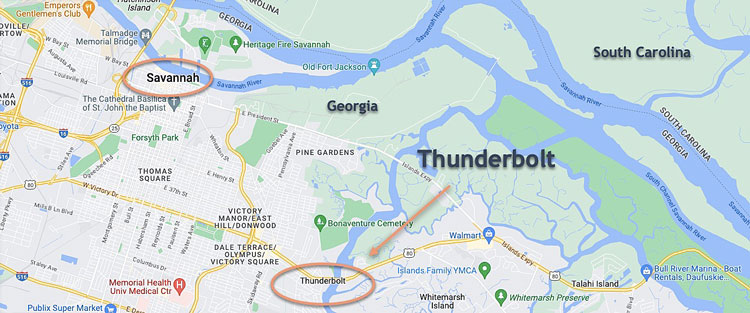
So, if you are southbound on the ICW, the distance from Hilton Head Island, South Carolina, to Thunderbolt, Georgia, is approximately 30-40 nautical miles depending on your exact starting and ending points, the route you take through the waterway, and other factors like tides and currents. While this is a rough estimation, the actual distance can vary based on your exact route, and it’s recommended to use navigational charts and GPS for precise measurements and directions when planning a boating trip. As all boaters know well, conditions on the water can change rapidly, and careful navigation is essential for safety. The town’s location on the Wilmington River makes it a convenient and scenic stop for boaters.
Thunderbolt, Georgia, is a small town located just southeast of Savannah. It is situated along the Wilmington River, which feeds into the Atlantic Ocean. Thunderbolt is a picturesque town with a unique blend of history, nature, and maritime culture. Its close proximity to Savannah and the Atlantic Ocean makes it a great place to visit and explore, offering a glimpse into the region’s rich past.
A small southern town with a long history
Before European settlement, the area was inhabited by Native American tribes, including the Yamacraw and Creek peoples. They settled near the river for fishing and trade, and their presence is still remembered today. During the colonial period, the land was used for farming and plantation purposes, as well as a hub for maritime activities. The town’s location on the Wilmington River made it an ideal spot for shipbuilding, fishing, and trade. In 1733, General James Oglethorpe, the founder of the Georgia colony, established a shipyard and small fort in the area to provide protection and support to the nearby settlement of Savannah.
Thunderbolt played a role in the American Civil War, as both Union and Confederate forces sought control of the strategically important town. In 1862, the town was briefly occupied by Union troops, and the local shipyard was burned to prevent Confederate use. Later in the war, Confederate forces established a naval station and battery in the area, but it was eventually captured by Union forces in 1864.
In the late 19th and early 20th centuries, Thunderbolt began to develop as a resort town, attracting visitors from Savannah and beyond. The town’s natural beauty, waterfront location, and easy access to Savannah via streetcar made it a popular destination for tourists seeking recreation and relaxation. The town experienced a period of growth and development, with new hotels, restaurants, and amusements catering to the burgeoning tourism industry.
A ghost story to make your hair stand on end
Among one of the most legitimately ghost-ridden houses in the U.S. is the Hampton Lillibridge House in Thunderbolt. It is a private residence and is not generally open to the public for tours or visits. So, don’t knock on their door, please. However, as I mentioned before, the house is often featured in Savannah’s ghost tours. While these tours typically don’t allow visitors inside the house, they do provide an opportunity to learn about the history and ghost stories associated with the property while viewing the exterior. It is the type of residence where the people who live in it must have made peace with themselves that they were sharing the premises with ghosts, whether they liked it or not.
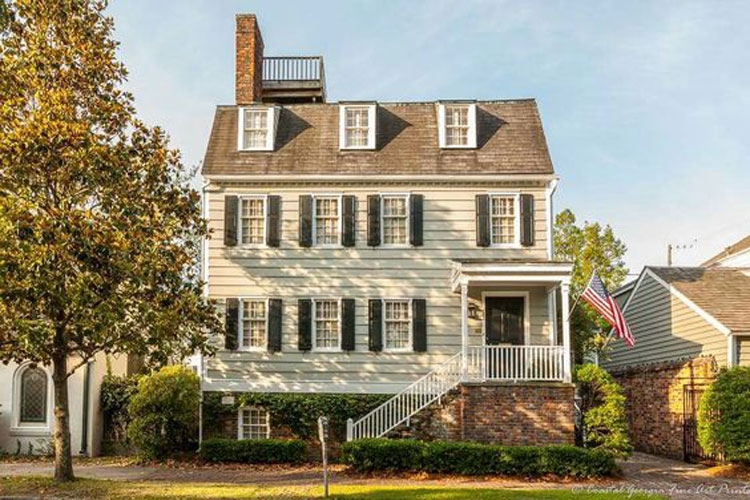
While the Joneses did not stop there, Fisher must have been curious about this unique spot in Thunderbolt and called the house. I suppose because he was from National Geographic, they took his call and he had the opportunity to talk to the owners of the house. In his book, Fisher wrote, “When I called at the house, it looked ordinary enough: a four-story, late 18th-century home with wooden superstructure and brick foundation. Built in 1796, it was moved in 1963 from its original location to the [present location]. Perhaps that’s what stirred up the ghosts. strange, loud noises and tools that moved about, terrorizing workmen. The owner heard footsteps and loud crashing noises; several guests heard a woman screaming; others saw a spectral gray-haired man in a gray suit.”
Fisher was welcomed by the owners of the property in 1972. He wrote, “she [the owner] showed me through the beautiful interior and described recent ghostly activity.” He continued sharing what he had learned firsthand from the owners.
“Our son, sleeping in his bed on the top floor, had a heavy flower pot crashed down on his head, cutting him. My husband, alone in the house, heard voices coming from the hi-fi when it wasn’t turned on. Another day he took a call from a patient on the kitchen telephone., then made an outside call; a few minutes later, he went upstairs and found the telephone off the hook and on the bed. He could not have received or made a call if the phone had been like that several minutes earlier. Yet, again, he was alone in the house.”
Now, that is first-hand, undeniable information, obtained from the homeowners who were prominent members of the community. It does not get better than that in any ghost story. But wait, remember, the stories started back in 1963 when the house was moved from its original location. Below is the condition of the house before it was moved and refurbished.
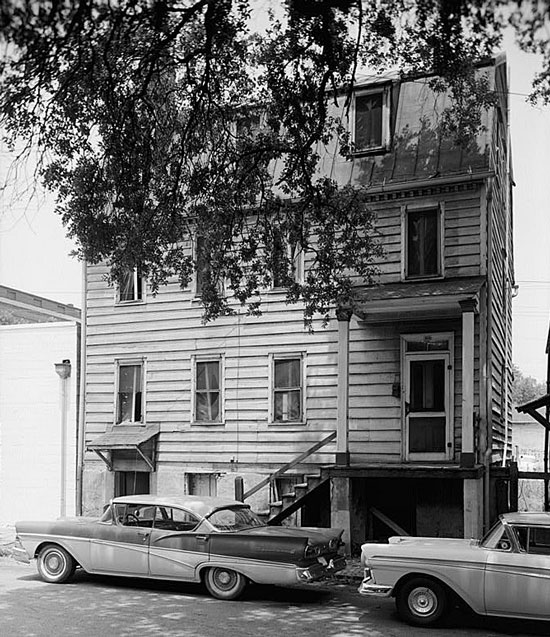
Libary of Congress
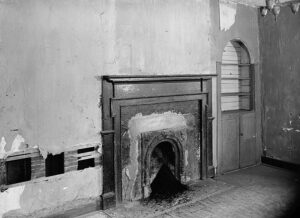
Today, it is a prime example of Georgian architecture featuring symmetrical proportions, a gabled roof, and a central entrance with a decorative pediment. The interior of the home showcases fine period details, such as heart pine floors, plaster moldings, and ornate mantels. It has a fascinating history.
The house was originally constructed around 1796 for a businessman named Hampton Lillibridge, a Rhode Island native who moved to Savannah. Lillibridge was a merchant and shipbuilder, and the home was one of the few remaining examples of post-Revolutionary War architecture in the city. Today, the Hampton Lillibridge House stands as a testament to Savannah’s rich architectural heritage and the efforts of preservationists like Jim Williams to save these important structures. As I mentioned before, the house is privately owned, but its exterior can be admired as you stroll through the city’s historic district.
In the 1960s, the house was in a state of disrepair and faced the threat of demolition. Jim Williams, a prominent Savannah preservationist and antique dealer, purchased the house in 1963 with the intent of restoring it. In order to save the structure, Williams decided to move it to its current location. The move was a major undertaking, as it involved dismantling the house, numbering the pieces, and then reassembling them at the new site. Workmen would often find bones inside the dismantled walls. The process took several years, and the restored Hampton Lillibridge House was finally completed in the late 1960s.
The house is considered one of the most haunted places in Savannah, a city with a reputation for being steeped in ghostly tales and paranormal activity. According to local legend, after the house was moved and restored by Jim Williams, strange occurrences began to happen. Workers reported hearing footsteps, strange noises, and even seeing apparitions during the restoration process. Some believe that a malevolent spirit, possibly from a crypt found on the property during the relocation, is responsible for the paranormal activity.
One of the most famous stories involves a worker who was painting the house’s exterior. Allegedly, he was up on a ladder when he saw a man in a black suit with a ruffled shirt standing behind him. Startled, he turned around, but no one was there. He fled the scene, refusing to return to work at the house.
Additionally, the house’s attic is believed to be a hotbed of paranormal activity, with some claiming to hear ghostly laughter and unexplained noises. Visitors have reported cold spots, strange odors, and an overwhelming sense of dread in the attic.
What else in Thunderbolt?
While Thunderbolt doesn’t have an “Old Town” in the same sense as Savannah’s Historic District, Thunderbolt does have several points of interest that are worth exploring:
The town has a designated historic district that features a mix of residential and commercial buildings, showcasing the area’s fishing village heritage and its history as a resort town. The district includes historic homes, churches, and businesses. On the waterfront, Thunderbolt’s location along the Wilmington River provides scenic views and opportunities for boating, fishing, and waterside dining. The waterfront area is a great place to enjoy a leisurely stroll and take in the picturesque surroundings.
While Thunderbolt may not have the same concentration of historical landmarks and attractions as Savannah, it offers a unique and charming atmosphere, with a rich maritime history and beautiful waterfront setting. Visiting Thunderbolt can provide a relaxed and enjoyable experience for those looking to explore the area’s smaller communities and natural beauty.

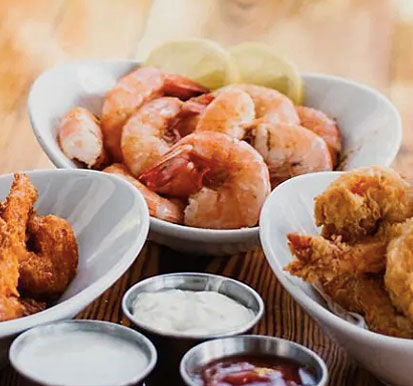
Thunderbolt has maintained a strong connection to its fishing village roots, with commercial fishing and shrimping remaining important industries for the town. One of the most famous local seafood markets is Russo’s Seafood Market. While it’s technically located in Savannah, it’s just a short drive away from Thunderbolt and is a favorite among locals for fresh seafood. They’ve been in business for over 70 years. They are a popular destination for both locals and tourists. This family-owned and operated business has been a staple in the area for decades, known for its wide variety of seafood, including locally-sourced fish, crab, oysters, and Georgia shrimp.
Thunderbolt has a strong fishing industry, with llocal seafood markets offering fresh catches from the nearby waters. Visiting a seafood market allows you to sample the local flavors and experience the town’s fishing heritage firsthand. Also, Thunderbolt’s close proximity to Savannah makes it easy to explore the city’s Historic District and other attractions, while still enjoying the small-town charm of Thunderbolt.
For something directly in Thunderbolt, you might check out the seafood available at local restaurants or stores. Some marinas might also have connections to local seafood providers. As always, it’s best to check the most current local resources or ask other boaters in the area for their recommendations.
Well, that’s it for now. Stay well. I hope to say hello to you if you spot my boat, Life’s AOK, in one of the locations that I’m hoping to visit in 2023, that is, if whatever the latest version of the pandemic permits us.
I bid you Fair Winds and Following Seas.
Cover photo: Tubby’s Restaurant in Thunderbolt, GA. Fresh. Local. Seafood & Southern Favorites. Courtesy of TripAdvior.com
1 thing I learned
I learned the latest status of the house. The current state of the Hampton Lillibridge House created skeptics.
2 things I recommend
- If you want to learn more, read the full story of the Hampton Lillibridge House.
- If you’re interested in the area’s haunted history, there are several other locations in the city that are open to the public and offer guided tours, such as the Sorrel-Weed House, the Mercer Williams House (made famous by the book “Midnight in the Garden of Good and Evil”), and the Colonial Park Cemetery. These sites provide an intriguing glimpse into Savannah’s past, along with the chilling tales and legends that have captured the imagination of locals and visitors alike. So, consider taking a terror tour: Savannah Terrors.
- Don’t miss the local fresh sea food of the town
How easy?

Marinas where you can stay overnight or longer
As a popular stopping point for boaters traveling along the Intracoastal Waterway (ICW), Thunderbolt is home to several marinas, These marinas provide a glimpse into the area’s maritime culture and history. If you are cruising along the ICW, stopping in Thunderbolt, Georgia, can be an excellent idea. The town’s location on the Wilmington River makes it a convenient and scenic stop for boaters. Additionally, its proximity to Savannah allows you to easily explore the historic city and enjoy its many attractions.

There are several marinas in Thunderbolt that cater to boaters, including some high-end options. A couple of the top marinas in the area are:
Thunderbolt Marine Inc: Located at 3124 River Dr, Thunderbolt, GA 31404, Thunderbolt Marine is a full-service marina and boatyard that offers transient dockage, fuel, and other amenities for boaters. They have a reputation for excellent service and high-quality facilities. They also offer repair and maintenance services if your vessel needs any work.
Bahia Bleu Marina: Situated at 2812 River Dr, Thunderbolt, GA 31404, Bahia Bleu Marina is another high-quality marina that offers a range of services for boaters, including transient dockage, fuel, and pump-out services. The marina is well-maintained and features modern amenities, making it a comfortable and convenient stop along the ICW.
Both marinas provide easy access to Savannah and the surrounding area, allowing you to explore the local history, culture, and natural beauty during your stop in Thunderbolt.
*SBFL stands for Slow Boat to Florida. Each numbered heading has two parts. The first is “Planned or Planning to Visit,” and when we visit the planned location, a “Visited” label appears at the beginning, next to SBFL.
Join us on our journey of discovery along the Atlantic Intracoastal Waterway (ICW)! We’re taking you with us, through our blog “Trips of Discovery,” as we follow in the footsteps of three National Geographic editors – Dorothea and Stuart E. Jones and Allan C. Fisher, Jr. In this series, we’ll show you the past, present and a glimpse into the future, as we compare and contrast the locations visited by the Joneses (1958 National Geographic article, “Slow Boat to Florida”) and Fisher (1973 book, “America’s Inland Waterway”), respectively. But don’t worry, we’ll add our own personal touch by sharing our observations and interviews with local residents during our visits.
In this series, we’ll take you to some of the most historic and charming spots along the ICW and share our personal observations and experiences. Who knows, you might even be inspired to plan your own adventure!
My wife and I hope you’ll be able to join us on the journey, either by boat or by car. Don’t hesitate to reach out and share your own insights or experiences about the locations we visit. We’d love to hear from you and keep the conversation going! And if not, don’t worry, you can still follow along as armchair travelers! So sit back, relax, and let’s embark on our Trips of Discovery of the ICW.

